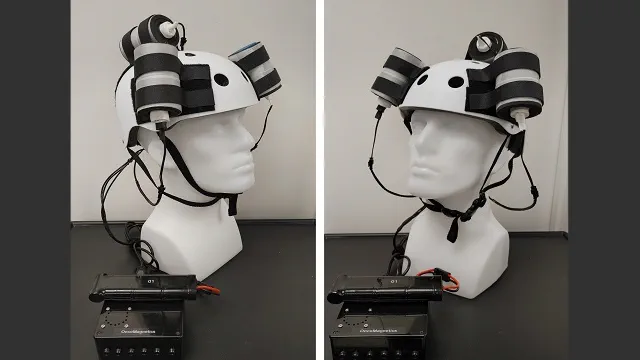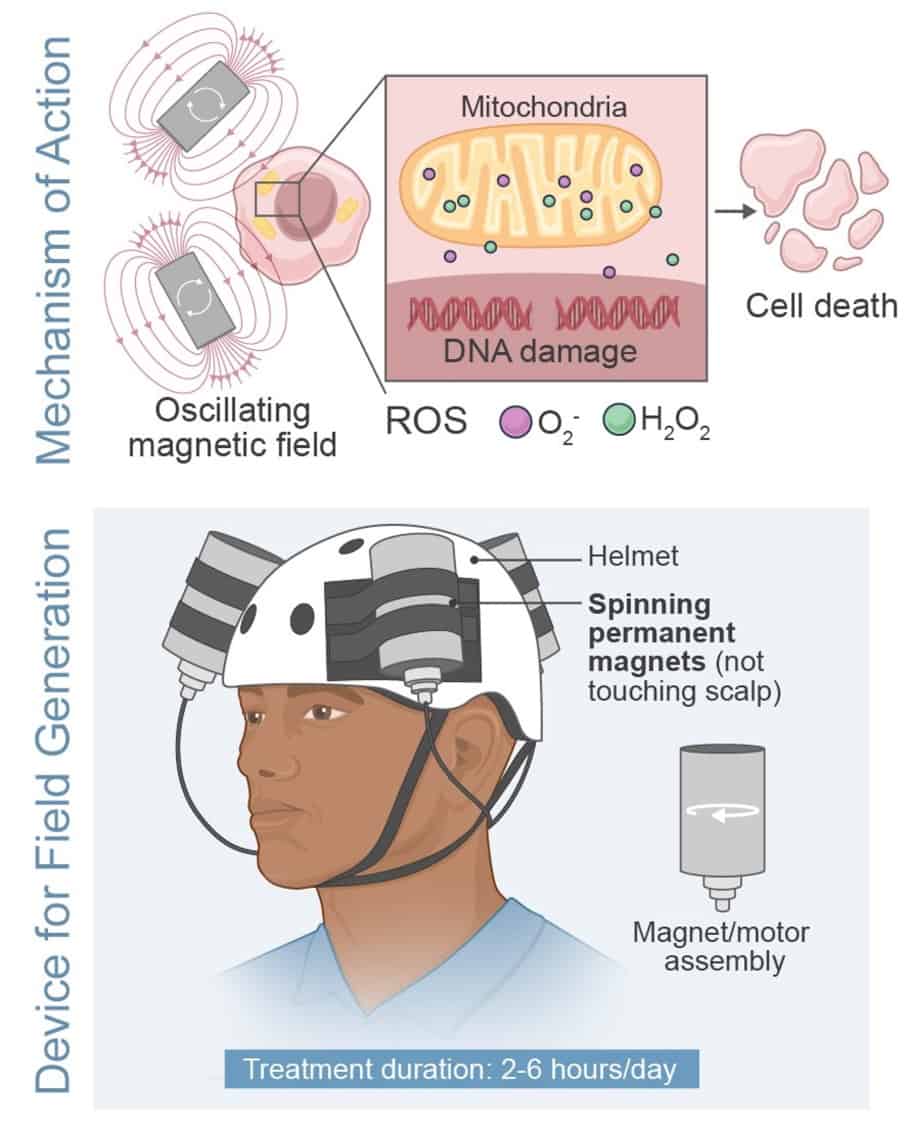In the realm of medical science and technology, the study “Spinning Magnetic Field Patterns that Cause Oncolysis by Oxidative Stress in Glioma Cells” marks a pivotal point in cancer treatment. It introduces the Oncomagnetic device, a groundbreaking innovation designed to selectively eliminate cancer cells through reactive oxygen species (ROS) elevation. This advancement offers a beacon of hope for noninvasive and potentially more effective treatment strategies for glioblastoma (GBM) and other gliomas, potentially revolutionizing the way we approach cancer therapy.
The Oncomagnetic Device: A New Hope in Cancer Treatment

Developed by a team including Shashank Hambarde and Jeanne M. Manalo, the Oncomagnetic device utilizes spinning oscillating magnetic fields (sOMF) to target cancer cells. Key features of this device include:
- Magnetic Flux Density: Carefully calibrated, ranging from 0.42 mT to 58.3 mT.
- Peak Frequency of Oscillation: Optimal frequencies around 135 Hz and 277 Hz.
- Intermittent Stimulation: Effective in inducing ROS with a pulse duration of 250 ms and varying off times.
- Temperature Control: Maintains a constant temperature to ensure hyperthermia doesn’t contribute to the effects.
This device’s ability to selectively induce cancer cell death while sparing normal cells is a testament to the potential of electromagnetic fields in medical applications.

The Flip Side: Electromagnetic Fields in Everyday Life
While electromagnetic fields (EMFs) show therapeutic promise, their ubiquity in modern life through devices like cell phones and wireless networks raises health concerns. Significant studies have linked RF radiation from these devices to potential health risks:
- Interphone Study: Suggested increased glioma risk with high mobile phone use.
- Hardell Group Studies: Found a pattern of increased risk for brain cancers with long-term use of mobile phones.
- U.S. NTP Study: Indicated a link between cell phone RF radiation and cancer in rats.
Frequency Modulation: A Complex Puzzle
Modern telecommunications often involve GHz frequency bands modulated into the Hz range. While the Oncomagnetic device operates directly within the Hz frequencies, the biological effects of GHz frequencies modulated into Hz remain largely unexplored. This gap in understanding presents a complex puzzle:
- Potential Resonance Effects: Hypothetically, Hz-range modulation could induce biological resonance effects, distinct from those caused by direct Hz frequency exposure.
- Research Necessity: There’s a pressing need for specific research to understand the health implications of modulated GHz-Hz frequencies, especially in comparison to direct Hz frequency exposure.
Implications and Future Directions
The dichotomy of electromagnetic fields – as both potential healers and harmers – underscores the need for a nuanced understanding of their interactions with biological systems. While the Oncomagnetic device illustrates the healing power of controlled electromagnetic fields in cancer treatment, the widespread exposure to RF radiation in our daily lives calls for a precautionary approach and further research.
Conclusion
The groundbreaking Oncomagnetic device highlights the therapeutic possibilities of electromagnetic fields, offering a novel approach to cancer treatment. Simultaneously, the pervasive nature of RF radiation in our wireless world and its potential health risks remind us of the dual nature of these forces. This intricate balance between healing and harming through electromagnetic radiation invites a deeper exploration into the invisible waves that surround us, shaping the future of medical science and public health.
Beyond Heating: Oncomagnetic and TheraBionic Devices Reveal New Biological Roles of Non-Ionizing Frequencies
The advancements made by the Oncomagnetic and TheraBionic devices in medical science are challenging the longstanding belief that non-ionizing radiofrequency radiation (RFR) only affects biological systems through heating. These innovations support a new understanding that non-ionizing frequencies can have active biological roles in the human body, marking a significant shift from the outdated model of RFR health effects.
Oncomagnetic Device: A Pioneer in Cancer Treatment
The Oncomagnetic device, used in treating glioblastoma and other gliomas, employs spinning oscillating magnetic fields (sOMF) to selectively target cancer cells. It operates under the principle that certain non-ionizing frequencies, specifically in the Hz range, can induce oxidative stress in cancer cells, leading to cell death. This approach defies the traditional belief that non-ionizing radiation’s effects are limited to thermal interactions.
TheraBionic: Revolutionizing Liver Cancer Therapy

Similarly, TheraBionic utilizes RF radiation at frequencies and power levels much lower than those of cell phones to treat inoperable liver cancer. This device operates in a frequency range overlapping with human audible sound and employs Hz frequency amplitude-modulated radiation. TheraBionic’s success demonstrates that non-ionizing radiation can exert therapeutic effects through mechanisms beyond mere heating.
Redefining Non-Ionizing Radiation’s Biological Role
Both the Oncomagnetic and TheraBionic devices exemplify the emerging understanding that non-ionizing frequencies can actively interact with biological systems in ways previously unrecognized. This challenges the conventional view that non-ionizing radiation, like that from cell phones and wireless networks, is biologically inert except for its thermal properties.
Implications for Public Health and Safety Standards
This new understanding of non-ionizing radiation’s biological activity necessitates a reevaluation of public health guidelines and safety standards. The traditional division between ionizing and non-ionizing radiation, based largely on their potential to cause thermal damage, appears increasingly insufficient to address the complexity of health effects related to RF radiation exposure.
The Need for Advanced Research
The revelations brought about by the Oncomagnetic and TheraBionic devices underline the need for more comprehensive research into the non-thermal effects of RF radiation. This research should aim to understand the broader implications of RF exposure, especially from everyday sources like mobile phones and wireless networks, and its potential long-term health impacts.
The breakthroughs achieved by the Oncomagnetic and TheraBionic devices in utilizing non-ionizing frequencies for medical treatments mark a significant shift in our understanding of RF radiation’s role in human health. As we continue to uncover the complex interactions between non-ionizing radiation and biological systems, it’s imperative that our public health policies, safety standards, and research methodologies evolve in tandem. By doing so, we can harness the full potential of this technology, ensuring its safe application in medical treatments while safeguarding public health in our increasingly wireless world.
In conclusion, the Oncomagnetic and TheraBionic devices are not just medical breakthroughs; they are catalysts for a paradigm shift in our understanding of non-ionizing radiation’s effects on human health, challenging us to reconsider and reevaluate the frameworks we’ve long taken for granted in assessing the safety and potential of RF radiation.








